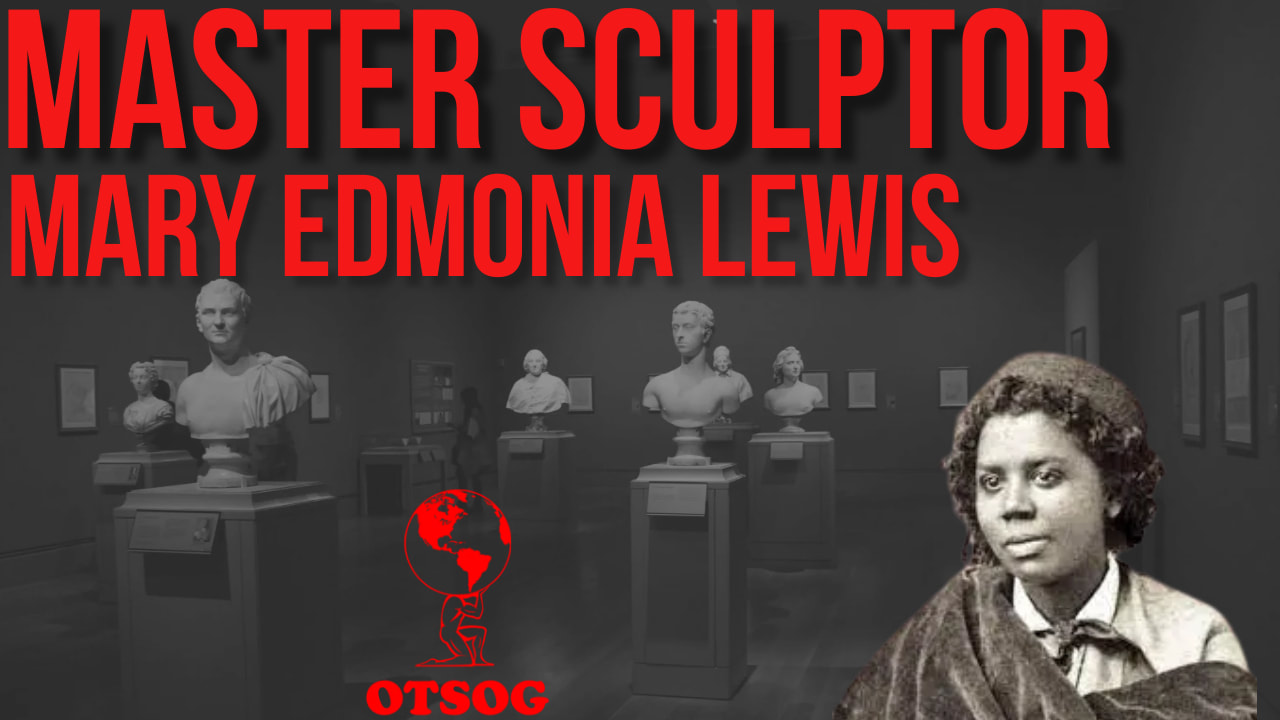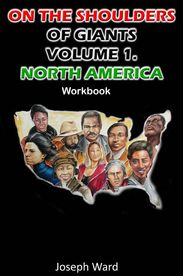|
July 4, 1844, is said to be the birth date of Edmonia Lewis, but that date is not confirmed, because Edmonia Lewis was known to embellish the details of her childhood, so there is no official account of her birth date or parts of her early childhood. We do know she was born in Rensselaer, Ney York, a city located across the Hudson River from Albany, New York. Her mother was named Catherine Lewis, who was a half Indigenous American of the Mississauga tribe and half African American from Canada. Catherine was also a very skilled craftswoman. She used those skills to provide for her family. There are several accounts of who Edmonia’s father was. Some believe he was a free black man named Samuel Lewis, others believe her father was the half African American and half Indigenous American author Robert Benjamin Lewis. When Edmonia reached the age of 9, unfortunately, both her mother and father passed away, so she and her brother Samuel moved to upstate New York to live with their maternal aunts. Lewis’ tribal name was Wildfire and her brother was Sunrise; they were called by these names when they lived with their aunts. Lewis and her aunts weaved baskets and made moccasin shoes and blouses to sell to the tourist at Niagara Falls. Lewis and Samuel lived with their aunts for 4 years until Samuel moved to San Francisco to find work. Samuel became wealthy through the California gold rush, so he was eager to pay for his sister's education. Lewis enrolled in the New York Central College’s pre-colligate program. New York Central College was a Baptist abolitionist school. She attended the school for three years before being dismissed from the school for what Lewis states as “being called wild”. When Lewis lived with her parents and aunts she lived a nomadic lifestyle until the age of 12, before being sent to the school. Despite the label of wild and being dismissed from the school, information was found to prove she was an excellent student. Lewis’ brother Samuel then sent his sister to the Oberlin Academy Preparatory School, she attended the school for three years before being admitted into Oberlin College. During her time at Oberlin, she lived with Reverend John Keep and his wife and added Mary to the beginning of her name, now being called Mary Edmonia Lewis. She received a well-rounded education, studying subjects from zoology to sculpting, and was known to use her unbound imagination to create art. Lewis was labeled as mischievous, being one of the few women of color at the school. She stated that she often faced racism. Lewis eventually left Oberlin college, some believe she was forced out, because of an incident with two white female students that tarnished her name. In January of 1862, two of Lewis’ housemates were preparing for an unsupervised sleigh ride to visit their boyfriends during a holiday break. In an attempt to help keep the girls warm Lewis served the girls spiced wine. During the sleigh ride, the girls became very sick and were believed to be poisoned, so that meant that Lewis was the suspect. Sources state that via medical testimony, Lewis added Spanish fly to the spiced wine for the girls. Charges were filed against Lewis and she would later have to attend trial. Lewis was not arrested and the local news outlets didn’t make the story a headline until the trial. A group of terrorists kidnapped and beat Lewis very badly one night as she was leaving Reverend Keep’s home, in retaliation to the girls being poisoned. Lewis’ initial court date for the alleged poisoning was delayed because of her injuries. The trial officially started on February 27, 1862, Lewis was represented by a mixed-race attorney named John Mercer Langston. Langston was a skilled lawyer and used his skills to obtain an insufficient evidence verdict for Lewis’ trial. Charges were dropped against Lewis but the public humiliation and tarnishing of her name had just begun. She was later accused of stealing art supplies and helping someone burglarize local properties, both charges were dropped against her. By this time it had become very difficult for Lewis to continue attending Oberlin, so she eventually left the school. In 1864, Lewis moved to Boston, Massachusetts to start her career as an artist, which was still funded by her brother. It is said she saw a statue of Benjamin Franklin and was inspired to become a sculptor. While in Boston, Lewis was able to connect with an abolitionist community which helped her meet other sculptors and artists. Reverend Keep wrote a letter of recommendation for Lewis to help her connect with the abolitionist community and to find a mentor. She would eventually become an apprentice to the sculptor Edward Augustus Brackett. Brackett provided Lewis with clay, tools, and know-how, to help her become a master sculptor. She became a very good sculptor in a short period of time, she was mastering sculpting with clay and plaster. She would often make sculptures and medallions of popular abolitionists. Lydia Maria Child was an abolitionist and interviewer. On several occasions, she would interview Lewis and display her work in newspapers. Lewis found early success with her sculptures. She participated in a local fair to help raise money for the all-black Massachusetts 54th Infantry, she made a bust of Sergeant William H. Carney, the first black man to be awarded the Congressional Medal of Honor, and Robert Gould Shaw, commander of the infantry. Lewis admired the infantry and Commander Shaw, especially for his work with the abolitionist. Commander Shaw honored Lewis by purchasing a bust. In 1865, Lewis would sell photos and copies of the bust to help fund a trip to Italy. Lewis stated that while living in Italy she could create her art free of racism and gender discrimination. She arrived in Italy in 1865, where she studied with sculptors Hiram Powers and Thomas Ball, two men that helped her improve greatly as a sculptor. She then moved to Rome where she joined a group of women who left the U.S. and Brittan to find a place to create art. She began sculpting with marble when she moved into the former home of the famous sculptor Antonio Canova. To help make a living she created and sold small busts and full-length sculptors. She completed her first masterpiece in 1867 Forever Free. A sculpture that depicted two African slaves becoming free. Lewis did return to the U.S. briefly to attend a dedication to the sculpture at Tremont Temple in Boston. Meanwhile, back in Italy, Lewis had become highly publicized by the media outlets. Her sculpture The Arrow Maker, a depiction of an Indigenous American father showing his daughter how to shoot an arrow, also gain much acclaim. Living and creating in Italy allowed Lewis to forge a great career for herself. She was able to make substantial amounts of money from her sculptures. She was also able to display and sell her art at numerous art exhibitions throughout the world. The Death of Cleopatra was created for the 1876 Centennial Exposition in Philadelphia, Pennsylvania. The sculpture was also highly acclaimed by many art enthusiasts and experts. The piece did come with some controversy over the symbol of the sculpture and the details added, some felt Lewis could not openly use the piece to express the plight of African American people. The sculpture was placed in storage for a while, then purchased and placed on the grave of a racehorse, before finally being placed in the Smithsonian in 1994. Lewis was hired to create the portrait of then-president Ulysses S. Grant. He was very happy with the final product. Lewis would also create a bust of then-senator Charles Sumner. Lewis created her sculptures in the neoclassicism style, a style of art that began in the mid-1800s in Italy and France. By the late1880s, neoclassicism was going out of style and Lewis’s popularity was declining but she continued to create busts, some that were later found and curated. Lewis died on September 17, 1907, in London, England. She is regarded as the first black woman to be internationally recognized as a master sculptor. She is the sculptor whose shoulders even the great sculptor Meta Vaux Warrick Fuller stands on. When she found her passion she did not allow anyone or anything to stop her. To make her dream come true she even moved to another country. To the great Mary Edmonia Lewis, we proudly stand on your shoulders. J.A. Ward Click here to support the OTSOG book series. References: https://en.wikipedia.org/wiki/Edmonia_Lewis https://www.theartstory.org/artist/lewis-edmonia/life-and-legacy/
0 Comments
Leave a Reply. |
Details
Categories
All
Click Here to join our mailing list
|
Contact Us: |
Connect With Us |
Site powered by PIT Web Design


 RSS Feed
RSS Feed



